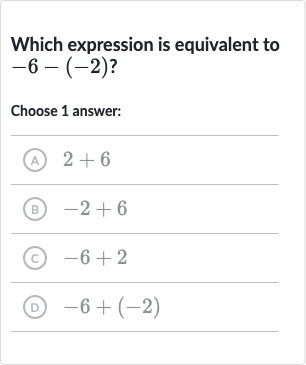Full solution
Q. Which expression is equivalent to Choose answer:(A) (B) (C) (D)
- Understand the operation: Understand the operation. Subtracting a negative number is the same as adding its positive counterpart.
- Perform the operation: Perform the operation. is equivalent to because subtracting a negative is like adding a positive.
- Simplify the expression: Simplify the expression. .
- Match the result: Match the result with the given choices.The equivalent expression to is not directly listed, but we can see which choice simplifies to .(A) simplifies to , which is not .(B) simplifies to , which is not .(C) simplifies to , which is the correct simplification of the original expression.(D) simplifies to , which is not .

